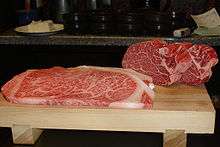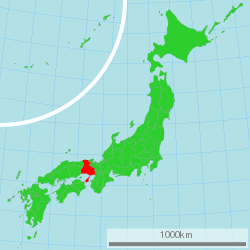Kobe beef


Kobe beef (神戸ビーフ Kōbe bīfu) is meat from the Tajima strain of Japanese Black cattle, raised in Japan's Hyōgo Prefecture according to rules set out by the Kobe Beef Marketing and Distribution Promotion Association.[1] The meat is a delicacy, valued for its flavor, tenderness, and fatty, well-marbled texture. Kobe beef can be prepared as steak, sukiyaki, shabu-shabu, sashimi, and teppanyaki. Kobe beef is generally considered one of the three top brands (known as Sandai Wagyuu, "the three big beefs"), along with Matsusaka beef and Ōmi beef or Yonezawa beef.
Kobe beef is also called Kobe niku (神戸肉, "Kobe meat"), Kobe-gyu (神戸牛) or Kobe-ushi (神戸牛, "Kobe cattle") in Japanese.[1]
History


Cattle were brought to Japan from China at the same time as the cultivation of rice, in about the second century AD, in the Yayoi period.[2]:209 Until about the time of the Meiji Restoration in 1868, they were used only as draught animals, in agriculture, forestry, mining and for transport, and as a source of fertiliser. Milk consumption was unknown, and – for cultural and religious reasons – meat was not eaten.[3][4]
Japan was effectively isolated from the rest of the world from 1635 until 1854; there was no possibility of intromission of foreign genes to the cattle population during this time. Between 1868, the year of the Meiji Restoration, and 1887, some 2600 foreign cattle were imported, including Braunvieh, Shorthorn, and Devon.[5] Between about 1900 and 1910 there was extensive cross-breeding of these with native stock. From 1919, the various heterogeneous regional populations that resulted from this brief period of cross-breeding were registered and selected as "Improved Japanese Cattle". Four separate strains were characterised, based mainly on which type of foreign cattle had most influenced the hybrids, and were recognised as breeds in 1944. These were the four wagyū breeds, the Japanese Black, the Japanese Brown, the Japanese Polled and the Japanese Shorthorn.[5] The Tajima is a strain of the Japanese Black, the most populous breed (around 90% of the four breeds).[6][7]
Beef consumption remained low until after World War II. Kobe beef grew in popularity and extended its global reach in the 1980s and 1990s.[8]
In 1983, the Kobe Beef Marketing and Distribution Promotion Association was formed to define and promote the Kobe trademark. It sets standards for animals to be labeled as Kobe beef.[9]
In 2009, the USDA placed a ban on the import of all Japanese beef to prevent the Japan foot-and-mouth outbreak from reaching US shores. The ban was relaxed in August 2012. Shortly thereafter, Kobe beef was imported into the US for the first time.[10]
Industry
Kobe beef in Japan is a registered trademark of the Kobe Beef Marketing and Distribution Promotion Association (神戸肉流通推進協議会 Kōbeniku Ryūtsū Suishin Kyōgikai).[11] It must fulfill all the following conditions:[1]
- Tajima cattle born in Hyōgo Prefecture
- Farm feeding in Hyōgo Prefecture
- Bullock (steer or castrated bull)
- Processed at slaughterhouses in Kobe, Nishinomiya, Sanda, Kakogawa, or Himeji in Hyōgo Prefecture
- Marbling ratio, called BMS, of level 6 and above[12]
- Meat quality score of 4 or 5[12]
- Gross weight of beef from one animal is 470 kg or less.
The cattle are fed on grain fodder and brushed sometimes for setting fur.[13][14] The melting point of fat of Kobe beef (Tajima cattle) is lower than common beef fat.[15]
Wagyu beef is much higher in unsaturated fat. It has high levels of oleic acid, the fatty acid in olive and canola oil that has been shown to lower bad LDL cholesterol. Tajima cattle are fattened longer, living about 26 to 32 months, compared to 18 months for US beef cattle.
Kobe beef is expensive, as only about 3,000 head of cattle may qualify as Kobe.[5] As of March 2018, imported Kobe beef on sale in Harrods cost £625 per kilo.[16] In Japan, all cattle, not just those that end up as Kobe beef, can be tracked via a 10-digit number through every step of its entire lifecycle.[17]
Kobe beef in other countries
Prior to 2012, Kobe beef was not exported. The first exports, in January 2012, were to Macau, then to Hong Kong in July 2012.[18] Since then, exports have also been made to the United States, Singapore, Thailand[19], the United Kingdom[20] and one chef in Canada.[21]
"Kobe-style" beef
The increase in popularity of Japanese beef in the United States has led to the creation of "Kobe-style" beef, taken from domestically raised Wagyu crossbred with Angus cattle, to meet the demand. Farms in the United States and Britain have attempted to replicate the Kobe traditions.[22] From the first Wagyu cattle imported in the 1970s, 150 US ranches now raise "tens of thousands of Wagyu cattle".[23]
The meat produced by these cross-breeds is different from the "authentic" Kobe beef, though this is "often by design", due to the perception that American palates do not actually want the richness of Japanese beef and would prefer a more familiar flavor profile.[6] Some US meat producers claim any differences between their less expensive "Kobe-style" beef and true Kobe beef are largely cosmetic.[24] Cuts of US "Kobe-style" beef tend to have darker meat and a bolder flavor.[25]
In Europe, UK grocery retailer Asda, owned by Walmart, introduced Wagyu beef at the end of 2011 under its Butcher’s Selection line using meat from a herd in Yorkshire, "bred from Holstein dairy cows impregnated with Wagyu semen". This not only made the beef more affordable, but it also resulted in less marbled meat more familiar to UK consumers.[3] In June 2014, the German discounter Aldi announced that it was going to introduce Wagyu beef steaks, "with every store receiving a limited number of 50 steaks, priced at a very competitive £6.99 for an 8-oz (225-g) sirloin and rib eye". However, Aldi’s Wagyu beef was sourced from New Zealand, where the exclusively grass-fed cattle are allowed to roam, more in keeping with changing norms around animal welfare (in Japan cattle are "confined in small pens and given much more energy-dense feed").[3]
Mislabelling

The proliferation of beef outside Japan marketed as Kobe beef is an issue for Kobe beef farmers. Due to a lack of legal recognition of the Kobe beef trademark in the United States, it is possible to sell meat that is incorrectly labeled as Kobe beef.[26][27] The Kobe Beef Marketing and Distribution Promotion Association planned to publish pamphlets about Kobe beef in foreign languages.[28]
Japan has a Wagyu Beef Export Promotion Committee.[6]
See also
References
- 1 2 3 "Kobe Beef Marketing & Distribution Promotion Association Bylaws". Retrieved 30 September 2010.
- ↑ Valerie Porter, Lawrence Alderson, Stephen J.G. Hall, D. Phillip Sponenberg (2016). Mason's World Encyclopedia of Livestock Breeds and Breeding (sixth edition). Wallingford: CABI. ISBN 9781780647944.
- 1 2 3 Simone Baroke (8 August 2014). "Japanese Wagyu Beef – Too Authentic?". Global Meat News.
- ↑ Y., Grant (1 December 2008). "The Real Beef on Kobe Beef". Cheff Seattle.
- 1 2 3 Bennett, Steve. "History of Wagyu beef cattle breed in Japan". www.wagyuinternational.com. Retrieved 15 December 2017.
- 1 2 3 Jim Vorel (24 February 2015). "Adventures in Beef: A First-Time Taste of Authentic Japanese Wagyu". Paste.
- ↑ Longworth, John W. (28 October 2004). "The History of Kobe Beef in Japan". Lucies Farm: Meat Digest.
- ↑ Meghan Staley. "Kobe Beef". Trade Environment Database. American University. Archived from the original on 28 March 2015.
- ↑ Krieger, Daniel (26 August 2010). "All for the love of Tajima cows". Japan Times.
- ↑ Olmsted, Larry (7 January 2014). "The New Truth About Kobe Beef". Forbes.
- ↑ "Kobe Beef Registered Trademarks". Retrieved 30 September 2010.
- 1 2 "Japanese Meat Grading" (PDF). Retrieved 3 August 2016.
- ↑ Mail magazine entitled Kobe Merumaga Club 2 June 2002 issue by Kobe City Office
- ↑ "edition September 19, 2007 issue". News Week Japanese. 19 September 2007. Archived from the original on 26 April 2009. Retrieved 16 March 2010.
- ↑ Shin-Onsen town office. "Taste of Tajima-ushi" (in Japanese). Retrieved 6 September 2010.
- ↑ Rayner, Jay (11 March 2018). "Farm Girl Café, Chelsea: 'We don't stay for dessert, because we have suffered enough' – restaurant review". The Guardian. Retrieved 12 March 2018.
- ↑ Yoshihisa, Godo. "The Beef Traceability System in Japan". FFTC Agricultural Policy Platform. Retrieved 15 December 2017.
- ↑ Jason Chow (27 July 2012). "Kobe Beef Arrives in Hong Kong". Wall Street Journal.
- ↑ "Kobe Beef Marketing and Distribution Information".
- ↑ Rayner, Jay (11 March 2018). "Farm Girl Café, Chelsea: 'We don't stay for dessert, because we have suffered enough' – restaurant review". The Guardian. Retrieved 12 March 2018.
- ↑ "If you think you've had Kobe beef in Canada, you're wrong. But here's your chance".
- ↑ "Cattle on 40 pints a day of beer". BBC News. 9 February 2007.
- ↑ J.C. Reid (13 March 2015). "American Wagyu and the myth of Kobe beef". Houston Chronicle.
- ↑ "American Kobe-style beef replaces the real thing". Associated Press. 29 December 2005. Retrieved 4 January 2013.
- ↑ Sayet, Jackie (6 October 2009). "Bogus beef: Miami restaurants say it's Kobe, but it's not". Miami New Times.
- ↑ Olmstead, Larry (12 April 2012). "Food's Biggest Scam: The Great Kobe Beef Lie". Forbes.
- ↑ Olmstead, Larry (7 January 2014). "Food's Biggest Scam, Part 2: "Domestic" Kobe And Wagyu Beef". Forbes.
- ↑ Yomiuri Shimbun (19 July 2008). "Kobe beef — Correct information for foreign countries" (in Japanese). Archived from the original on 18 October 2008. Retrieved 20 July 2008.
External links
| Wikimedia Commons has media related to Kobe beef. |